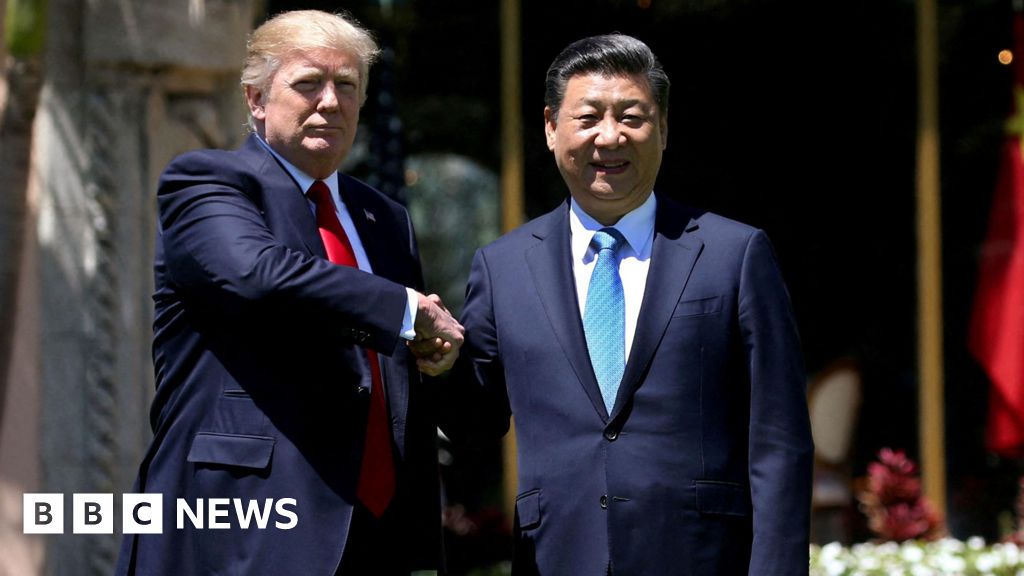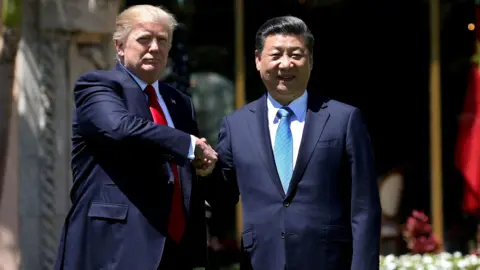Business
US and China agree framework of trade deal ahead of Trump-Xi meeting

Michael RaceBusiness reporter
 Reuters
ReutersThe US and China have agreed the framework of a potential trade deal that will be discussed when their respective leaders meet later this week, the US treasury secretary has said.
Scott Bessent told the BBC’s US news partner CBS that this included a “final deal” on TikTok’s US operations and a deferral on China’s tightened rare earth minerals controls.
He also said he did not anticipate the 100% tariff on Chinese goods threatened by President Donald Trump coming into force, while China will resume substantial soybean purchases from the US.
Both nations are seeking to avoid further escalation in a trade war between the world’s two largest economies.
Trump and Chinese President Xi Jinping are due to hold talks on Thursday in South Korea.
Bessent met senior Chinese trade officials on the sidelines of the Association of Southeast Asian Nations (Asean) summit in Malaysia, which Trump is also attending as part of a tour of Asia. Beijing said they had “constructive” discussions.
Bessent said the countries had “reached a substantial framework for the two leaders”, adding: “The tariffs will be averted.”
The Chinese government said in a statement that both negotiating teams “reached a basic consensus on arrangements to address their respective concerns”.
“Both sides agreed to further finalise specific details,” they added.
Trump’s tariff tactics
Since Trump re-entered the White House, he has imposed and threatened sweeping tariffs on imports from overseas on various countries, arguing that the policy would help boost US manufacturing and jobs. The introduction of tariffs has resulted in many countries, including the UK, agreeing new deals with the US.
But the steepest levies he has threatened have been levelled at China. Beijing has hit back with measures of its own, though the two agreed to hold off implementing the levies while pursuing a trade deal.
However, earlier this month Trump said he would impose an additional 100% tarriff on Chinese goods from November in response to China tightening restrictions on export of rare earths – materials essential to the production of many electronics. The US president accused Beijing of “becoming very hostile” and trying to hold the world “captive”.
China processes around 90% of the world’s rare earths, which go into everything from solar panels to smartphones, making supply of them to US manufacturers a key bargaining chip.
The last time Beijing tightened export controls – after Trump raised tariffs on Chinese goods early this year – there was an outcry from many US firms reliant on the materials.
China will “delay that for a year while they re-examine it”, Bessent told a different news show, This Week, on Sunday.
Another issue of contention is soybeans, of which China is the world’s biggest buyer. As the trade war began heating up, China halted all orders, hurting US farmers.
Bessent hinted the boycott may soon be over but refused to give details.
“I’m actually a soybean farmer, so I have felt this pain too… I think we have addressed the farmers’ concerns,” he said on This Week.
“I believe when the announcement of the deal with China is made public that our soybean farmers will feel really good about what’s going on for this season and the coming seasons for several years.”
TikTok deal done?
Bessent also said a deal had been agreed on video-sharing platform TikTok’s US arm, with Trump and Xi left to “consummate that transaction on Thursday”.
The US has sought to prise the app’s US operations away from Chinese parent company ByteDance over national security concerns.
TikTok was previously told it had to sell its US operations or risk being shut down, but Trump has delayed implementing the ban four times to facilitate negotiations, and has extended the deadline again to December.
The White House announced last month that US companies would control TikTok’s algorithm and Americans would hold six of seven board seats for the app’s US operations.
While Trump initially called for TikTok to be banned during his first term, he has since changed course. He turned to the hugely popular platform to boost his support among young Americans during his successful 2024 presidential campaign.
On Sunday, Washington also announced a slew of trade deals with Malaysia and Cambodia and framework agreements with Thailand and Vietnam.
The region, which is heavily dependent on trade with the US, is among the hardest hit by Trump’s tariffs.
The US will keep its tariff rate of up to 20% on each of the countries’ goods, but could carve out exemptions on certain products.
“Our message to the nations of South East Asia is that the United States is with you 100% and we intend to be a strong partner for many generations,” Trump said in Malaysia, the first stop of his week-long Asian tour.
Trump signed agreements involving the trade of critical minerals with Thailand and Malaysia. These expand the US’ access to rare earth elements and other metals beyond China.
Trump also announced framework agreements for the US to trade more goods with Cambodia and Thailand.
The White House and Vietnam announced “unprecedented” trade access between the countries. Vietnam also agreed to buying Boeing jets worth more than $8bn (£6bn) from the US and American agricultural goods.
Additional reporting by Osmond Chia
Business
Panel questions IndiGo, DGCA babus, gets ‘unconvincing’ replies | India News – The Times of India

New Delhi: IndiGo was quizzed on Wednesday by a parliamentary committee over the misery inflicted on passengers by its mass-cancellation of flights, but it blamed a variety of factors, including system glitch and adverse weather conditions, while DGCA and the aviation ministry parried off criticism of their role in the fiasco.Some committee members termed replies of different stakeholders as “unconvincing” and aimed at washing their hands of the crisis, encapsulated by the response of a govt official that he first came to know of the unfolding ordeal through media reports.The panel, headed by JDU’s Sanjay Jha, decided to wait for the report of an inquiry ordered by DGCA before coming to a conclusion and make its recommendation. It will hold another meeting and is expected to call these stakeholders again. The DGCA-ordered committee was constituted on Dec 5 and was asked to submit its report in 15 days.Captain Sam Thomas, president of Bengaluru-based Airline Pilots Association of India, created flutter at the meeting by alleging corruption in DGCA and was asked by members to refrain from making sweeping allegations without producing evidence. He alleged that one can commit any wrong, but stay safe if he touched right feet.A committee member said IndiGo, which has offered apology for the ordeal, was far from apologetic in its response before the panel. It told the panel that several factors combined to derail its operation, including a glitch in system, which needed rebooting, and adverse weather that had their pilots stuck in different zones.IndiGo was represented by its COO Isidre Porqueras, while officials of Air India, Akasa Air, Spice Jet and Air India Express appeared before the panel as well. Civil aviation secretary Samir Kumar Sinha and top functionaries of other stakeholders were part of the deliberations.Replying to a query, IndiGo said all luggage, except 52 which remained unclaimed, have already been delivered.The panel’s meeting came against the backdrop of the suspicion, subject of investigation, that IndiGo remained resistant to the implementation of guidelines (Flight Duty Time Limitation) that allowed more rest for pilots in line with global norms aimed at ensuring flyers’ safety.It has been accused of engineering the disruption, leveraging its market dominance, to force the ministry to roll back the regulation as implementing it would have required the airline to hire more pilots. Faced with chaos caused triggered by disruption of IndiGo’s operations, DGCA had to relax the implementation of the guidelines.IndiGo management is reported to have denied allegation in meetings with ministry.
Business
Historic Green Milestone: Indian Railways Achieve 99.2% Electrification, Leaves UK, Russia And China Far Behind

New Delhi: Indian Railways has reached a milestone in its journey toward sustainable transportation, achieving electrification of 99.2 per cent of its broad gauge network. This puts India ahead of major rail economies such as the United Kingdom, which stands at 39%, Russia at 52% and China at 82%, according to a press release from the Ministry of Railways.
The achievement brings the country closer than ever to operating a fully electrified railway system. Fourteen railway zones, including Central, Eastern and Northern Railways, have already achieved 100% electrification. In addition, 25 states and union territories have completed electrification across their rail networks.
Data provided in a written reply to the Lok Sabha highlights the rapid pace of this transformation. Between 2014 and 2025, India electrified 46,900 route kilometres, more than double the 21,801 route kilometres completed in the previous six decades.
In the past two years alone, 7,188 route kilometres were electrified in 2023-24 and 2,701 route kilometres in 2024-25.
The environmental benefits of this transition are major. Rail transport emits 89% less CO2 than road transport, and Indian Railways is complementing electrification with renewable energy initiatives. So far, 898 MW of solar power has been commissioned at 2,626 stations, reinforcing India’s commitment to a greener transportation network.
Electrification is advancing consistently across zones. The Central, East Coast, East Central, Eastern, Konkan Railway, Kolkata Metro, North Central Railway, North Eastern Railway, Northern Railway, South Central Railway, South East Central Railway, South Eastern Railway, West Central Railway and Western Railway have achieved full electrification.
Other zones, such as North Western, Southern, Northeast Frontier and South Western Railway, have crossed 95% electrification.
The progress is equally impressive state-wise as well. Most states are fully electrified, while Rajasthan, Tamil Nadu and Karnataka are nearing completion. In the North Eastern region, the broad gauge networks in Arunachal Pradesh, Meghalaya, Nagaland, Tripura and Mizoram have been 100% electrified, while Assam stands at 92%, with work underway to complete the remaining sections.
All new rail lines and multi-tracking projects are now being sanctioned with electrification integrated from the beginning. According to the Ministry of Railways, the completion timeline for electrification projects depends on factors such as forest clearances, relocation of utilities, statutory approvals, geological and topographical conditions, law and order situations and climatic constraints, which can affect progress at different project sites.
Beyond expanding connectivity, electrification is central to India’s sustainability agenda. The move to electric rail corridors is helping dramatically cut carbon emissions. For instance, transporting 1 tonne of freight over 1 km emits 101 g of CO2 by road, compared with just 11.5 g by rail, an almost eightfold reduction.
The Indian Railways aims for 100% electrification while contributing to the nation’s goal of net-zero carbon emissions by 2030. Every new rail project now includes electrification from the outset, ensuring that India’s railway system grows greener, more efficient and globally competitive.
Business
Medical supply firm Medline jumps more than 30% in debut after biggest IPO of 2025

Shares of U.S. medical supplies giant Medline jumped more than 30% in its debut on the Nasdaq on Wednesday after the biggest initial public offering of the year globally.
The stock opened at $35, up from its $29 IPO price.
The private equity-owned company sold a little over 216 million shares on Tuesday, raising $6.26 billion in an upsized offering that finished off a strong year for new listings and bolstered optimism about the IPO market in 2026. Shares of Medline will trade under the symbol MDLN.
That IPO pricing gives Medline a market value of at least $37 billion, based on the shares listed in its regulatory filings.
“Historically, we’ve done very little advertising, very little marketing, and this gives us a way to amplify our voice and actually expand really the receptivity of who we are,” Medline CEO Jim Boyle told CNBC’s “Squawk Box” earlier Wednesday. “We are the largest company you’ve never heard of, and we happen to be everywhere. And that’s a really interesting thing.”
The U.S. IPO market has held steady despite market volatility in the spring, driven by President Donald Trump’s sweeping tariffs, and the longest U.S. government shutdown in history in the fall. Just over 200 IPOs have priced this year, including Medline, which is the largest U.S. listing since Rivian‘s $13.7 billion deal in November 2021, according to data compiled by CNBC.
But Medline’s IPO is also among the biggest private equity-backed listings. Three private equity firms — Blackstone, Carlyle and Hellman & Friedman — acquired a majority stake in the company in 2021 for a whopping $34 billion. At the time, the deal was the biggest leveraged buyout since the financial crisis.
CEO Jim Boyle celebrates with others as medical supplies giant Medline (MDLN) holds it’s IPO at the Nasdaq stock market site in Times Square in New York, Dec. 17, 2025.
Shannon Stapleton | Reuters
Medline, founded in 1966, is based in Northfield, Illinois. The company manufactures and distributes roughly 335,000 different medical and surgical supplies — from gloves, masks and scalpels to wheelchairs. Medline has customers in more than 100 countries and, as of the end of 2024, employed more than 43,000 workers worldwide.
Medline’s total debt was around $16.8 billion as of late September 2025. The company raked in $25.5 billion in net sales in 2024.
Medline’s earlier plans to go public this year were postponed due to uncertainty around tariffs affecting products from Asia. The majority of the company’s products are sourced or manufactured in Asian nations, particularly China.
Medline expects a $150 million to $200 million hit from tariffs to income before taxes in fiscal 2026.
The company competes with names like McKesson and Cardinal Health.
— CNBC’s Gina Francolla contributed to this report
-

 Business4 days ago
Business4 days agoHitting The ‘High Notes’ In Ties: Nepal Set To Lift Ban On Indian Bills Above ₹100
-

 Politics1 week ago
Politics1 week agoTrump launches gold card programme for expedited visas with a $1m price tag
-

 Business1 week ago
Business1 week agoRivian turns to AI, autonomy to woo investors as EV sales stall
-

 Tech1 week ago
Tech1 week agoJennifer Lewis ScD ’91: “Can we make tissues that are made from you, for you?”
-

 Sports1 week ago
Sports1 week agoPolice detain Michigan head football coach Sherrone Moore after firing, salacious details emerge: report
-

 Business1 week ago
Business1 week agoCoca-Cola taps COO Henrique Braun to replace James Quincey as CEO in 2026
-

 Fashion1 week ago
Fashion1 week agoTommy Hilfiger appoints Sergio Pérez as global menswear ambassador
-

 Tech1 week ago
Tech1 week agoGoogle DeepMind partners with UK government to deliver AI | Computer Weekly






